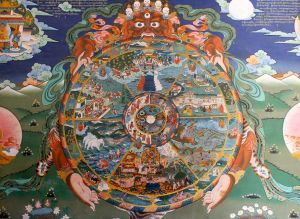What are the six realms?
Rebirth—being born again and again until nirvana ends the cycle—can be a difficult concept to embrace if you’ve been raised to believe in an eternal afterlife in heaven or hell. Non-Buddhists sometimes joke that being reborn as a bug is as bad it gets, but in the Buddhist depiction of the universe, it can get much worse than that!
The six realms of rebirth are a schema in which beings are reborn according to the kind of life they lived. The realms are depicted in the Wheel of Life (bhavachakra), a vivid representation of samsara—the cycle of birth, death, and rebirth.
The animal realm, in which inhabitants are driven by basic needs, is one of the three “lower” realms. The other two are the hell realm, a place of constant suffering and torment, and the realm of the hungry ghosts, grasping beings who are never satisfied. The three “higher” realms are the human realm, where you and I find ourselves; the demigod realm, where godlike beings fight for power; and the god realm, where beings enjoy a life of pleasure. It’s important to note that some Buddhists view the realms as literally real, while others interpret them psychologically as metaphors for the emotional states of the human condition.
Karma plays a role in determining where we are born and reborn, which keeps happening until we reach nirvana and escape the cycle. Until then, we are stuck in the six realms. But for those who interpret them as metaphors rather than actual places, the six realms depict life as we are living it here and now.
Animals are driven by their need to eat, sleep, and procreate; people in this state live mechanically, controlled by basic needs. The hell realm describes people living with extreme suffering, heedless of others. Their own hurt is so great they may even harm those around them. Hungry ghosts (pretas) are those driven by unquenchable desire, chasing the next possession, the next meal, the next relationship, only to find themselves dissatisfied and craving the next thing.
Those in the god realm (devas) float high above the world, free of suffering, but this realm too is ultimately unsatisfying. Without adversity, the gods develop attachments and have no motivation to escape samsara. The realm of demigods (asuras) is marked by constant warfare, competition, and anger; it is the home of climbers on the corporate and social ladders—those who are driven to get ahead.
The human world is the realm of action, the only one in which practice can take place and buddhas can appear. Here we find the only exit from the six realms—the liberation of nirvana. The human realm, the scriptures explain, is neither so pleasurable that there’s no motivation to seek liberation, like the higher realms, nor too full of suffering to attempt to escape samsara, like the lower realms. A human birth is said to be so rare and precious that a turtle surfacing in a vast ocean is more likely to put his head through a small ring floating on the surface than we are to get a human birth. This is why the Buddha urges us to put our human life to good use!
Source
[[1]]
